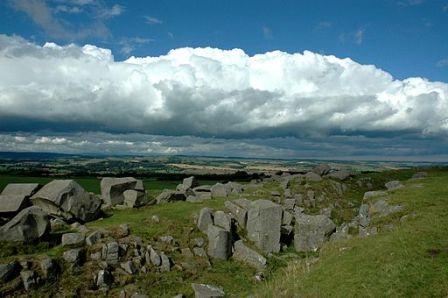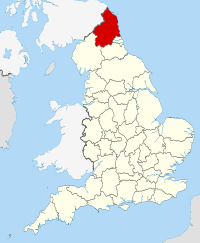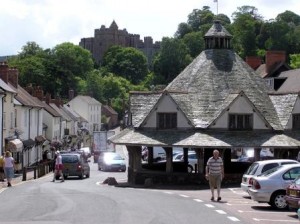
Hadrian’s Wall Stones at the Northumberland National Park, Northumberland, England – by Tomorrow Never Knows © Wikipedia commons
The Northumberland National Park is located in the county of Northumberland in north east England. Designated a national park back in 1956, the area is known for its scenic landscapes, tranquillity, remoteness, charming small towns and villages and for Hadrian’s Wall world heritage site located in the south of the national park. It is located between the cities of Newcastle and Carlisle and close to the border with Scotland.
Northumberland is the least populated of the national parks and enjoys feeling of calm and tranquillity to it, with some of the finest scenery in England.
The area is popular for day trippers, horse riding, fishing, bird watching, golf, rock climbing, walking and cycling with a number of routes to explore. Visitors can enjoy the open landscapes and variety of wildlife, take part in a number of activities and enjoy the great outdoors.
Quick Facts
Northumberland National Park:
Year of Designation: 1956
Population: 2,200
Scheduled Ancient Monuments: 196 and 1 world heritage site
Conservation Areas: 1 and 3 National Conservation Areas
Size in square kilometres: 1,048
Main Settlements: Bellingham, Haltwhistle, Rothbury and Wooler.
Located in: Northumberland.
Highest Point: The Cheviot at 815 metres.
Attractions
The Northumberland National Park is located in the north eastern English county of Northumberland, known as the most scarcely populated and most remote of the national parks in England. It offers an oasis of tranquillity and calm, a place to get away from it all and enjoy the natural environment. The park has a long history including Hadrian’s Wall located in the south, the prehistoric Cheviot Hills located to the north, it is thought the park has been inhabited for around 10,000 years leaving a wealth of history through archaeology. The park is known for its range of landscapes attracting many people each year and its geodiversity.
The location in the north of England close to the border with Scotland ensures the national park is located in an area away from major population centres and built up areas, ensuring its remote location. and in the counties of Hampshire and Wiltshire means visitors to Northumberland increase in the summer months with many visitors and holiday makers visiting the region on holiday and short breaks. Northumberland is located approx 330 miles from London, due to the distance, remote location and lower profile among national parks, it is sometimes missed by visitors. For visitors that do make the journey, the park is assessable by both road and public transport offering visitors with plenty of things to do, see and take part in.
The area is famous for its variety of landscapes, range of wildlife supporting a variety of habitats, charming local towns and villages that are full of history and character. The national park does not include any major cities or towns within its borders, the main settlements include Bellingham, Haltwhistle, Rothbury and Wooler with a number of smaller villages and hamlets. The cities of Carlisle and Newcastle are located to the west and east of the national park, each city is within 30 miles of the southern edge of the park.
The Special qualities relating to the areas landscape, heritage and history with ancient retains and a world heritage site, wildlife, natural beauty and rich biodiversity ensure Northumberland is a special place. The qualities include its ancient landscape dating back to the Stone Age, Cheviot Hills where there are ancient hill forts and pure rivers, the inspiring landscape that includes moors and valleys and a sense of peace and solitude, woodlands, heathland and a number of Sites of Scientific Interest (SSI). The national park benefits from its own distinctive character, way of life, traditions, folklore and strong local communities evident in its towns, villages and hamlets, archaeology, and nature conservation including Special Areas of Conservation and Ramsar sites.
Local accommodation includes a wide choice of hotels, cosy B & B’s, Guest Houses, Self Catering houses, cottages, camping and caravan facilities and farm and pub stays; there is accommodation available in Bellingham, Otterburn, Rothbury, Wooler and more that are all conveniently located for further exploring Northumberland. The cities of Carlisle and Newcastle offer a choice of accommodation, facilities, amenities and transport links to the national park.
Visitor attractions in the area include Hadrian’s Wall located in the south of the national park. The wall stretches for 73 miles across the north of England, its history and stunning location make it a must see attraction. Hadrian’s Wall is a World Heritage Site and includes rare wildlife, wonderful landscapes, archaeology and much more. Seen as a wonderful feat of engineering, the wall took six years to build and includes the Hadrian’s Wall Path National Trail that stretches for 84 miles from coast to coast. Attractions along the wall include Housesteads and Vindolanda Roman Forts, Walltown, a scenic country park with lake, Carvoran – Roman Army Museum, Greenlee Lough – National Nature Reserve and much more. The Hadrian’s Wall Country Bus is a great way to see and experience the attractions and places of interest around the wall.
Visitor & Information Centres are located at locations across Northumberland. The National Park Centre Once Brewed is the main visitor centre, located close to Hadrian’s Wall in Hexham, at the centre visitors will find knowledgeable staff with local knowledge on local attractions, things to see and do, local tips and advice. The centre includes books, maps, gifts and more. There are other information centres located around Hadrian’s Wall, Coquetdale, North Tyne & Redesdale and the Cheviots. A visit to the main centres and other visitor information points provide a good first port of call for visitors and can help to better plan, organise and enjoy your trip.
North Tyne & Redesdale has a scenic natural landscape where visitors can see rivers, forests, valleys and historic attractions. The area between Bellingham and Kielder is known for its valleys, whilst visitors may see otters in the streams and rivers. The historic market town of Bellingham along with Falstone, Greenhaugh and Tarset are well worth discovering and include a number of charming pubs and tea rooms with plenty of character. Local attractions include the Heritage Centre in Bellingham, it is also a tourist information centre, here visitors can find displays on local history including the Border Counties Railway and enjoy a choice of cakes and teas at the Railway Carriage Tea Room. The ruins of a Roman Fort can be found at High Rochester whilst the Otterburn Ranges is a large area used that is popular among walkers and cyclists.
Hareshaw Linn, are ancient woodland that includes mosses and ferns and a variety of wildlife including woodpeckers and red squirrels. Local plants include herb paris and bluebells, the woodland walk is approx 3 miles in distance and leads to the stunning 30 foot waterfall. The Kielder Water and Forest Park includes northern Europe’s largest man made lake and at over 250 square miles is the largest working forest in England. The scenic landscape makes the park popular with walkers, cyclists, outdoor enthusiasts, artists, explorers and families where visitors can benefit from the park’s remote location, clean air and green environment.
Coquetdale is a scenic area has a long and rich history, it is home to a number of historic houses, churches and castles. During the summer months the area hosts a number of community agricultural shows that are held in Coquetdale and around the national park. Barrowburn is located in Upper Coquetdale, here visitors can see hay meadows with wildflowers, further down the valley is Harbottle known for its historic castle ruins that date back to the 12th century and Drake Stone. Holystone is a stone built village that is best known for the Holy Well that is dedicated to the Virgin Mary, Woodhouses Bastle is a fortified farmstead dating back to the 17th century is located close by.
The town of
Rothbury is located on the banks of the River Coquet, the charming market town is surrounded by rolling hills, visitors can find a fine choice of local independent shops and a traditional town with a thriving community. Local attractions include Rothbury Church, Golf Club and a choice of routes for walkers and cyclists. In Rothbury and across the valley there are a number of festivals, fairs and shows that take place throughout the year. Visitors can go to the Simonside Hills that stretch for over 4 miles offering a great place to enjoy a picnic and some wonderful views over the Coquet Valley, the Cheviot Hills and the coastline.
The Cheviots Hills are located in the north of the national park close to the north with Scotland, the landscape is untamed and wild with valleys and hills. The area is famous for its rounded shaped hills that include bridleways and footpaths offering a number of interesting routes for walkers and mountain bikers. Adventurous visitors can try to climb The Cheviot at 815 metres, it is the highest point in the national park. The Breamish Valley is a popular destination for visitors, with a number of walks into the hills, local river side picnic areas and a number of hillfort archaeological sites that include Neolithic and Bronze Age burials, medieval villages, farmsteads and hillforts. Close by there is a scenic waterfall at Linhope Spout.
The Fenton Centre is located close to Wooler, it is an interesting and educational visitor attraction, here visitors can explore cultural heritage, countryside diversity, there are a number of displays, exhibitions, workshops and a range of events where visitors can learn more countryside life, rural economies and much more. The compact town of Wooler is a popular place from which to explore the Cheviot Hills, the high street includes a choice of shops, facilities and amenities. The hills that surround the town include a number of historic hillforts including the spectacular Yeavering Bell, an Iron age hillfort. The hills offer a number of exciting walks and cycling routes, it is located 15 miles from the Northumberland coastline. The town includes a choice of accommodation facilities including B & B’s, hotels, hostels and caravan and camping sites, making it a great place from which to explore the local and surrounding areas.
Guided Walks are available in Northumberland, with both National Park Rangers and Volunteer Rangers on hand to offer professional, knowledgeable advice and tips where visitors can benefit from local knowledge and expertise. Guided walks are available for visitors of different abilities with easy, moderate and strenuous walks available located around Hadrian’s Wall, Coquetdale, North Tyne and Redesdale and the Cheviot Hills offering a range of walks to explore the area and see the best in the varied wildlife and natural beauty of the park. Activities in the park include Horse Riding, Cycling, Bird Watching, Star Gazing, Rock Climbing, Golf and more with plenty to see and do for people of all abilities, with a range of things to see, so and experience, there is something for most tastes and interests.
For visitors the Northumberland National Park has plenty to offer, it is a popular destination for day trippers, weekend and short breaks offering a secluded haven away from the congestion, hustle and bustle of the cities and towns. The variety of landscapes, historic attractions including Hadrian’s Wall, scenic beauty, charming villages and hamlets makes Northumberland a great place to relax, recharge and get away from it all.
How to Get There
Northumberland is accessible by both car and public transport.
By Car:
Northumberland is located approx 330 miles from central London. From London, take the M1 motorway all the way to junction 32, then take the M18 then at junction 2 take the A1(M) towards Leeds then continue along the A1(M) and A1 until the junction with A697 take the A697 then the B6344 then the B6341. Then take Greenside Bank and Ridlees Road that goes into the national park. The approx journey time is 5 hours 30 minutes to 7 hours 30 minutes depending on traffic, time of day and breaks taken.
By Train:
The mainline trains stations at Newcastle and Carlisle have regular services from London. From London King’s Cross station there are services to Newcastle, the journey time is approx 2 hour 50 minutes to 3 hours 30 minutes, depending on service and time of day. There are services from London Euston station to Carlisle, the approx journey time is 3 hours 30 minutes to 4 hours 20 minutes depending on service, time of day and connections. The Hadrian’s Wall Bus runs between Newcastle and Carlisle stopping off at local towns, villages, attractions and places of interest along the route.
By Bus/Coach:
There are regular coaches available from London Victoria Coach station to Newcastle. The approx journey time is 6 hours to 30 minutes to 7 hours, depending on service, traffic and time of day. From Newcastle here are National Express coach services to Byrness in the national park, the approx journey time is 1 hour 10 minutes. Coach services are provided by National Express
Contact Details
Northumberland National Park Authority
Eastburn
South Park
Hexham
Northumberland
NE46 1BS
Telephone: +44 (0)1434 605555
email: enquiries@nnpa.org.uk
Website: Northumberland National Park Authority
Map
View Larger Map
For Local Search and Directions see: Northumberland National Park Map
Tips & Other Considerations
The weather and climate can be unpredictable, there can be elements of all four seasons in one day. Ensure you check the weather forecast before you travel and have the correct clothing and footwear including comfortable walking shoes, fleece, raincoat and umbrella.
Follow travel advice and remain alert, vigilant and aware of your belongings at all times especially your wallet/purse and valuables and ensure they are hidden away from public view. If you have a bag try to use a shoulder bag with a good quality, strong strap, that is put across your shoulder not on your shoulder making it more difficult for anyone to take your bag.
If you are travelling by car to Northumberland ensure you are well prepared with maps and Sat Nav to aid your journey, particularly if you are not familiar with the local area and roads. Use the journey planner for door to door directions. Check traffic updates before you travel.
If you are looking for car parking in and around the national park, ensure you fully understand the rules, regulations & charges for car parks and street parking. The rules & regulations can be complex & confusing if you are unclear, it is wise not to park there.
If you are travelling by public transport, check for service updates prior to beginning your journey for any delays, disruption or cancellations to services that may impact on your journey. Ensure you have the service timetables for the trains, trams, buses and coaches. Remember when the last services are and ensure you make it to the train/bus/coach stops well in time to avoid missing the service.
Disclaimer: The information given in on this website is given in good faith and to the best of our knowledge. If there are any discrepancies in no way do we intend to mislead. Important travel details and arrangements should be confirmed and verified with the relevant authorities.



